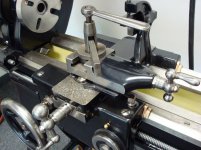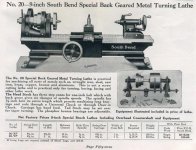jor2daje
Plastic
- Joined
- Jun 24, 2010
- Location
- California
Well after all my questions I think its finally time to show something for all the great info you guys have this forum. Im no where near done with this project but today I finished up a shelf and I decided its showing enough progress for me to do a mock up that I can show.
I started by tearing the lathe apart and cleaning all the old grease and oil off the bare metal, and using the wire brush to take all the painted areas back to the metal. Then I did my best to partially polish most of the parts that seem like they should be polished, these were then taped off and shot with some rustoleum hammered finish. I know this isnt the proper color (I believe this model is actually supposed to be black though Im not sure) but I really like this color combination. Also this lathe is going to a functional part of my workshop and several other tools have this paint. I have found it to be very durable and covers any surface imperfections very well.
(you probably have seen most of the pictures before but Id like them all in one thread)
The picture I got of it from the previous owner.

Everything assembled once I got it with my own motor on it.

Heres how its looking now, everything is moving great but Im still going to polish all the bare metal up to nicer shine. The shelf is just some 1" pine, I managed to mount it without drilling any holes into legs so if I choose to replace or remove it theres no damage to the legs.

Still working on the apron, luckily its very simple because apparently this lathe was never meant to have power feeds so no half nut levers or other stuff clean up. Once I get a new motor I think I will run the switches through the large holed the previous owner cut in the legs to try to cover them up in a useful way. After the main lathe is done I will concentrate my efforts on fixing up all the tooling that come with it.
I started by tearing the lathe apart and cleaning all the old grease and oil off the bare metal, and using the wire brush to take all the painted areas back to the metal. Then I did my best to partially polish most of the parts that seem like they should be polished, these were then taped off and shot with some rustoleum hammered finish. I know this isnt the proper color (I believe this model is actually supposed to be black though Im not sure) but I really like this color combination. Also this lathe is going to a functional part of my workshop and several other tools have this paint. I have found it to be very durable and covers any surface imperfections very well.
(you probably have seen most of the pictures before but Id like them all in one thread)
The picture I got of it from the previous owner.

Everything assembled once I got it with my own motor on it.

Heres how its looking now, everything is moving great but Im still going to polish all the bare metal up to nicer shine. The shelf is just some 1" pine, I managed to mount it without drilling any holes into legs so if I choose to replace or remove it theres no damage to the legs.

Still working on the apron, luckily its very simple because apparently this lathe was never meant to have power feeds so no half nut levers or other stuff clean up. Once I get a new motor I think I will run the switches through the large holed the previous owner cut in the legs to try to cover them up in a useful way. After the main lathe is done I will concentrate my efforts on fixing up all the tooling that come with it.









